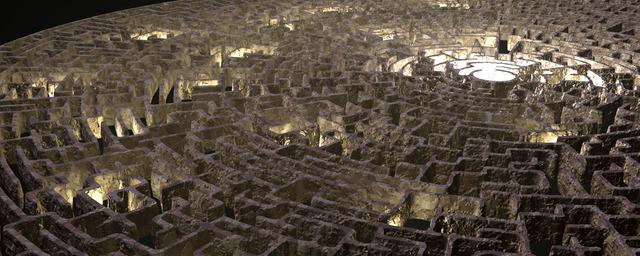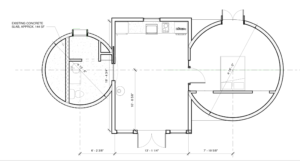We Need to be Asking God Sized Questions Instead
Asking a man-sized question is a sure way to get a man-sized answer. As humans it makes sense that we think in human terms, because we are human after all. But what could be possible if we quit limiting ourselves? Because when we incorporate these limitations, we are limiting God’s answer.
This is a little bit like the cute little girl who went into the pet store and shyly asked the store owner for a small rabbit. The store owner asked her what color she would like. “We have black ones, brown ones, white ones. What color would you like?”

The little girl said, “It doesn’t matter, my python won’t care.
The store owner asked a man-sized question. He made some presumptions about what the little girl’s plans were for the rabbit and then asked the question. We do this kind of thing all the time when asking questions of God. We limit His answers with our small questions.
God has a lot bigger plans for us than we have for ourselves.
In Luke 20:27-38, the Sadducees, who didn’t believe in a resurrection, asked Jesus a question about a woman who was childless when her husband died. According to the writings of Moses, the husband’s brother should marry her. In this story the brothers kept dying and the next one would marry her.
The question from the Sadducees was, “In the resurrection, whose wife would she be?”
This is one of those man-sized questions.
Jesus goes on to explain to them that marriage is a worldly thing designed for companionship, family and filling the earth. In Heaven there will be no need for marriage. We will be like the angles.

We need to be thinking bigger, out of the box questions and then have faith that God will answer them. This doesn’t mean that the answer will be what we think or expect. We need to change our simple-minded thinking.
We need to quit holding God back with our small questions.
In Mark 11:23-24, we are told that if we, “…tell a mountain to be lifted up and thrown into the sea, and don’t waiver, that it will happen”. I don’t know about you, but my small man-sized brain finds this hard to believe.
The first vision that comes to my mind is the mountain being lifted from the earth and floating to the nearest ocean and being dropped in. The Scripture doesn’t get into the specifics. Maybe it could involve some big excavation equipment or new technology.

Think about President Kennedy when he said that we would put a man on the moon…and we did. That sounded pretty far fetched when it was said, but it happened. President Kennedy had faith. This doesn’t mean that it was easy, or that a man just magically floated up to the moon.
This was a God-sized idea that required the faith and hard work of a lot of people.
We need to think bigger and have more faith. If we align our man-sized thinking with God’s and remove our human-sized limits, we will be amazed when that mountain is in the sea.
















 join the family at the supper table. His mother, as usual, told him to go wash his hands. As the little boy headed to the sink he said, “Jesus and germs, that’s all I ever hear around here and I haven’t ever seen either one.”
join the family at the supper table. His mother, as usual, told him to go wash his hands. As the little boy headed to the sink he said, “Jesus and germs, that’s all I ever hear around here and I haven’t ever seen either one.” 


 This is a big struggle that I have when scheduling. I know that I’m deadline oriented. If I allow two hours to do something it will most likely take twice that long. If I allow four hours, it reduces the level of urgency and I will
This is a big struggle that I have when scheduling. I know that I’m deadline oriented. If I allow two hours to do something it will most likely take twice that long. If I allow four hours, it reduces the level of urgency and I will  procrastinate. Something else will take its place. I’ve figured out that If I schedule myself short on time, I focus better, and the increased urgency will get it done faster. Figuring out your balance of accuracy and urgency can be tricky but is critical.
procrastinate. Something else will take its place. I’ve figured out that If I schedule myself short on time, I focus better, and the increased urgency will get it done faster. Figuring out your balance of accuracy and urgency can be tricky but is critical. tendency of trying to do too many things has always been a characteristic that I have been proud of. This is what movers and shakers do, right. Being a micro-manager doesn’t help either. There are just
tendency of trying to do too many things has always been a characteristic that I have been proud of. This is what movers and shakers do, right. Being a micro-manager doesn’t help either. There are just 

 slicing mature bamboo poles into strips. Then these strips are cut into the desired lengths and widths, the outer skin and nodes are removed, and the strips are boiled in a solution of boric acid or lime to remove the sugar and starch. After it has been dried and planed the strips are laminated together, milled, sanded and finished creating the planks with either vertical or horizontal grain. Bamboo can be installed either with an interlocking joint system, nailed or glued. This product can be refinished however staining bamboo can be a challenge.
slicing mature bamboo poles into strips. Then these strips are cut into the desired lengths and widths, the outer skin and nodes are removed, and the strips are boiled in a solution of boric acid or lime to remove the sugar and starch. After it has been dried and planed the strips are laminated together, milled, sanded and finished creating the planks with either vertical or horizontal grain. Bamboo can be installed either with an interlocking joint system, nailed or glued. This product can be refinished however staining bamboo can be a challenge. squares that used to be installed in homes. This product is made of resilient polyvinyl chloride (PVC) with a top layer of urethane. It comes in planks (to look like traditional wood floors), tiles (that can look like ceramic, stone, granite, marble, etc.) and is even available in patterns that resemble carpet squares. Luxury vinyl will range from 2mm to 5mm thick. It can be installed either in a snap together floating system or glued down.
squares that used to be installed in homes. This product is made of resilient polyvinyl chloride (PVC) with a top layer of urethane. It comes in planks (to look like traditional wood floors), tiles (that can look like ceramic, stone, granite, marble, etc.) and is even available in patterns that resemble carpet squares. Luxury vinyl will range from 2mm to 5mm thick. It can be installed either in a snap together floating system or glued down.
 I grew up repurposing, before it had a cool name like that. I remember as a kid setting on the concrete step of the barn straightening bent nails that had been pulled out of used boards. We had cans full of them and when doing a new project, we would repurpose them.
I grew up repurposing, before it had a cool name like that. I remember as a kid setting on the concrete step of the barn straightening bent nails that had been pulled out of used boards. We had cans full of them and when doing a new project, we would repurpose them.

